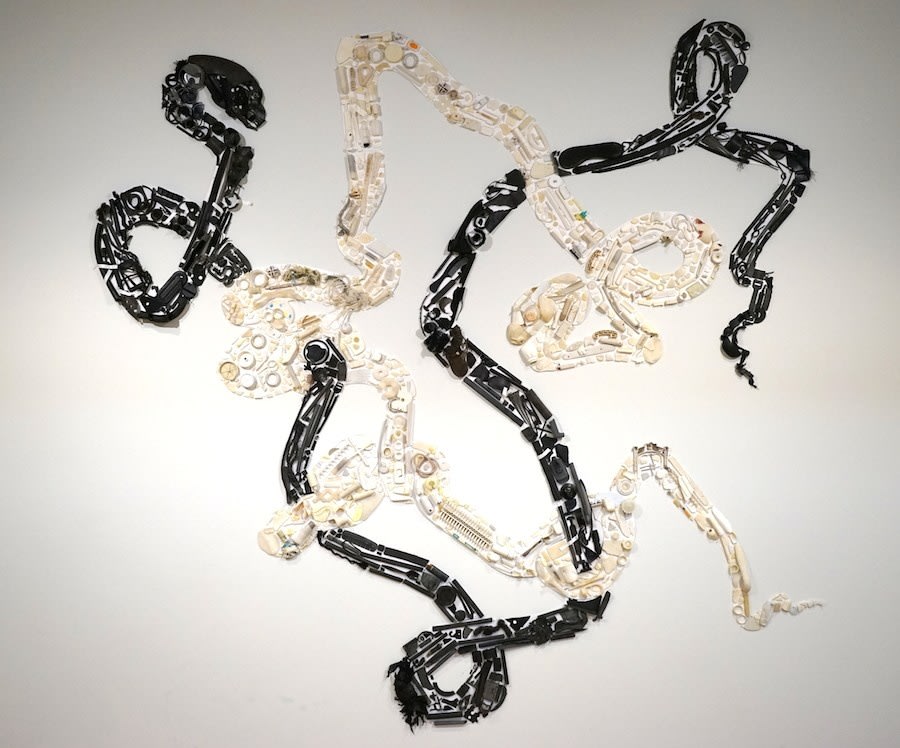Pam Longobardi’s Drifters Project, an exhibition of photography and installations made from ocean plastic, draws to a close at 24 N Lexington Avenue at the end of this month. It has been a real privilege to share her work with you, and we’re excited to welcome Longobardi for a closing reception/gallery talk/book signing on Friday, February 1st, at 5PM. This event is free and open to the public. The artist will talk about her experiences with refugees in the Mediterranean and her work that addresses the environment, climate change, and humanitarian issues. Light refreshments will be served during this Artist Reception and Book Signing. We hope to see you there.

Longobardi’s artwork involves painting, photography, and installation to address the psychological relationship of humans to the natural world. She has exhibited her artwork across the US and in Greece, Monaco, Germany, Finland, Slovakia, China, Japan, Italy, Spain, Belgium, Costa Rica and Poland. She currently lives and works in Atlanta and is Professor of Art at Georgia State University. Presently she drifts with the ongoing Drifters Project, following the world ocean currents. With the Drifters Project, she collects, documents and transforms oceanic plastic into installations and photography. The work provides a visual statement about the engine of global consumption and the vast amounts of plastic objects and their impact on the world’s most remote places and its creatures. Longobardi’s work is framed within a conversation about globalism and conservation. Longobardi participated in the 2013 GYRE expedition to remote coastal areas of Alaska and created project-specific works for the exhibition at the Anchorage Museum February 2014. Longobardi was featured in a National Geographic film on the GYRE expedition and her Drifters Project was featured in National Geographic magazine. Also in 2013, Longobardi created a site-specific installation for a special project of the Venice cultural association Ministero di Beni Culturali (MiBAC) and the Ministry of Culture of Rome for the 55th Venice Biennale, on the Island of San Francesco del Deserto in the Venetian Lagoon, a work made from plastic water bottles, mirrors and a satellite dish that signaled an apology to St. Francis across the lagoon to the island of Burano. She exhibited photography in Seescape at George Adams Gallery in New York, and won the prestigious Hudgens Prize (2013), one of the largest single prizes given to an artist in North America. She has an ongoing collaboration supported by the Ionion Center for Art and Culture in Metaxata, Kefalonia, Greece. In 2014, Longobardi was awarded the title of Distinguished University Professor, and has been named Oceanic Society’s Artist-In-Nature.

About Drifters Project, Longobardi comments:
“In 2006, after discovering the mountainous piles of plastic debris the ocean was depositing on the remote shores of Hawaii, I began collecting and utilizing this plastic as my primary material in my project called Drifters. Since then, I have made scores of interventions, cleaning beaches and making collections from all over the world, removing thousands of pounds of material from the natural environment and re-situating it within the cultural context for examination. These collection missions were originally done solo, as part of my process, but soon grew to encompass thousands of people in hundreds of global sites. I approach the sites as a forensic scientist, examining and documenting the deposition as it lay, collecting and identifying the evidence of the crime.
Plastic objects are the cultural archeology of our time. These objects I see as a portrait of global late-capitalist consumer society, mirroring our desires, wishes, hubris and ingenuity. These are objects with unintended consequences that become transformed as they leave the quotidian world and collide with nature to be transformed, transported and regurgitated out of the shifting oceans. The ocean is communicating with us through the materials of our own making. The plastic elements initially seem attractive and innocuous, like toys, some with an eerie familiarity and some totally alien. At first, the plastic seems innocent and fun, but it is not. It is dangerous. We are remaking the world in plastic.
In keeping with the movement of drift of these material artifacts, I prefer using them in a transitive form as installation. All of the work can be dismantled, reconfigured but nearly impossibly recycled. The objects are presented as specimens on steel pins or wired together to form larger structures. I am a conceptual artist with a strong affinity to materials and process. I was trained as a painter and printmaker, and continue this in my studio practice, but have always worked in varying mediums from photography to painting and collage to installation, allowing the ideas to dictate the materials I work with. I am interested in the collision between nature and global consumer culture. Ocean plastic is a material that can unleash unpredictable dynamics. I am interested in it in particular, as opposed to all garbage in general, because of what it reveals about us as a global culture and what it reveals about the ocean as a type of cultural space, as well as a giant dynamic engine of life and change. As a product of culture that exhibits visibly the attempts of nature to reabsorb and regurgitate this invader, ocean plastic has profound stories to tell.”
